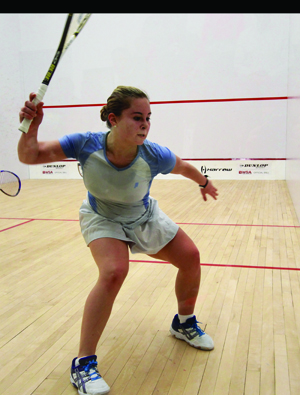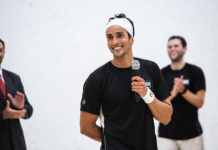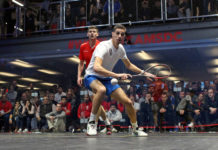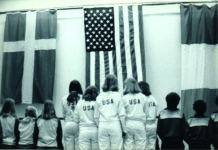By Chris McClintick
In the spring of 1922, Howard Roark—the protagonist in Ayn Rand’s 1943 novel The Fountainhead—chooses to leave his architecture school, not compromising his personal architectural beliefs in adhering to the school’s conventionalism.
Nearly ninety years later, eighteen- year-old Olivia Blatchford—similar to Roark’s decision in her favorite book— veered away from conventionalism in perhaps the most pivotal decision of her life: electing to bypass college in pursuit of a professional squash career.
When making her decision in Au- gust of 2011, Blatchford was buoyed by a 2010 that saw her best string of Women’s Squash Association (WSA) performances to date: reaching her first final in January’s Liberty Bell Open, two consecutive semifinals in February’s Delaware Open and $20,000 Dayton Open as a qualifier, winning her first WSA title—The SRC Open—seeded third in May, and qualifying for her first Carol Weymuller Open main draw in October.
With quarterfinal appearances in the $25,000 Atwater Cup and $20,000 Veracruz International, a semifinal berth in the $10,000 St. Louis Racquet Club Invitational, and achieving a second place finish as part of the United States Junior World Championship team un- der her belt in 2011, Blatchford made her decision to turn professional leading up to the $25,000 Jericho Open in Vancouver, Canada.
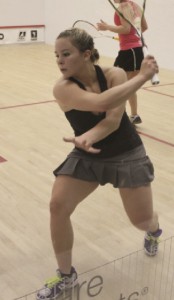
Like Roark, the aftermath of her decisive career choice was strewn with setbacks. Seeded seventh in her maiden tournament as a declared professional, Blatchford was defeated by current world No. 35 Misaki Kobayashi in the first round.
Despite a promising start to 2012 where she reached the semifinals of the Liberty Bell Open, Blatchford exited eight of her next nine WSA events in the first round of qualifying or the first round of main draw play.
“Everyone thought I was crazy be- cause I didn’t want to go to college,” Blatchford said. “I didn’t want to do it. I didn’t want to go to college at the time.”
“Then I went through a period where I was just playing, and I struggled. I think I had a lot of stuff going on in my mind. I also felt like people were thinking: ‘Well she didn’t go to college so she better do something right away and be pretty good.’ I had pretty high expectations for myself and after a while I thought ‘I don’t know if I can do this at all.’ So I decided to take some time off and reevaluate what I was doing, which is when I started coaching.”
That summer, Blatchford joined 2013 U.S. champion and U.S. national team player-coach Natalie Grainger as a squash teaching professional at the recently opened eleven-court Chelsea Piers complex in Stamford, Connecticut—a short commute from her hometown of Wilton.
“I was on court a lot with my students who would tell me all about their close matches, wins and losses, and I found myself appreciating the game again from a different perspective. I started getting jealous of my students, missing the fight and the battle. So I got back into it.”
After a four month hiatus and with her lowest world ranking of seventy- six since August of 2011, Blatchford returned to the court as a playing professional competing in three tournaments before the year’s end. First, in the nearby $10,000 Pyramid International that yielded a first round, five- game loss to the formidable Lauren Selby. She then traveled north of the border to Toronto’s Canadian National Squash Academy where she reached the semifinals of the $10,000 NSA Fall Classic with a five-game quarterfinal upset of two seed Maria Toorpakai Wazir, and ended 2012 on a somewhat disappointing note, losing to teenage English qualifier Nada Elkalaawy in the first round of the $10,000 Colwyn Classic in Wales.
A week before her twentieth birth- day and still recovering from the flu, Blatchford traveled to Berwyn Squash and Fitness for January’s 2013 Liberty Bell Open. For her fifth appearance in the $5,000 Philadelphia tournament since first participating at fourteen years of age in 2007, Blatchford entered the tournament with a revitalized mindset.
“I told myself going into the Liberty Bell Open: ‘I’m just going to play and enjoy this.’ I didn’t have any expectations whatsoever,” Blatchford said. “I remember thinking: ‘Alright, I can do this. It’s going to be hard, but it’s not as hard as I make it for myself emotionally. Some days you’re going to win, some days you’re going to lose. Just keep going, don’t be so negative and judgmental all the time, and this could be a lot of fun.’”
Without dropping a game on her way to the final, and with the Liberty Bell Open title on the line, Blatchford found herself down 2-0 against U.S. Junior Open champion and fellow U.S. national team member, Sabrina Sobhy. Like her shift in mindset, Blatchford shifted the momentum of the final winning the last three games and her second career WSA title.
That momentum carried through the spring as she notched her first career win in Grand Central Terminal—her favorite professional tournament that she first attended as a kid—over higher-ranked Lucie Fialova, reached the semifinals of the U.S. Championships, qualified for the Mayfair and Granite Opens in March, made two consecutive WSA Tour 10 quarterfinals, and was one of three U.S. national team members to reach the individual semifinals of the Pan American Federation Cup held in Buenos Aires.
As the U.S. women collected gold in the Pan American team competition, US SQUASH announced the Elite Athlete Program, an initiative to support American players at an adequate level to allow them to train and compete profession- ally on a full-time basis. For Blatchford, the timing couldn’t have been better.
“I was already planning on dialing down my coaching before I found out about the EAP,” Blatchford said. “I was already itching to go on tour full- time, and the EAP wouldn’t allow me to coach. I immediately thought: ‘Alright, let’s go.’”
“I spent a lot of time coaching, and it’s hard spending those hours on court when you need to be training. It adds up and takes its toll. Squash is a difficult career in that sense because you really can’t do both, but at times, you need to do both. You need a supplemental source of income, but at the same time you need to rest and take care of your body. In that sense, squash is taking a risk on yourself.”
“That’s where the EAP program comes in so handy as I’m just starting again in a different way, having US Squash back me up and supporting me while I’m taking that risk—and they’re also taking a risk and investing in me— so that, in the future, there is more of a base for funding and success.”
Blatchford is currently focused on training full-time and building the physicality required to compete at the highest level in the world.
“I am trying to make changes in my game, looking to get fitter, and that’s really been my Achilles heel from the time I was younger: being lean and fit enough to play. Right now most of my numerical goals are on a scale!”
Her training has already paid dividends as she qualified for the U.S. Open women’s draw in October, and upset fellow American and world No. 30 Latasha Khan to reach the semifinals of the LA Open in mid-November. Blatchford— now world No. 51—is aiming to qualify for World Series events, and having her most successful year on the world tour to date in 2014. She will travel across the world to compete in the Hong Kong Open in December.
“I don’t know where I would be if I had made a different decision between going to college and becoming professional, but I’m happy with where things are headed right now.”


